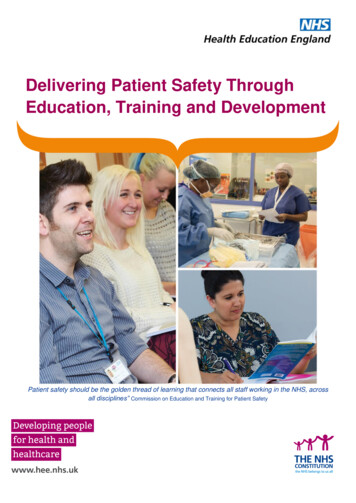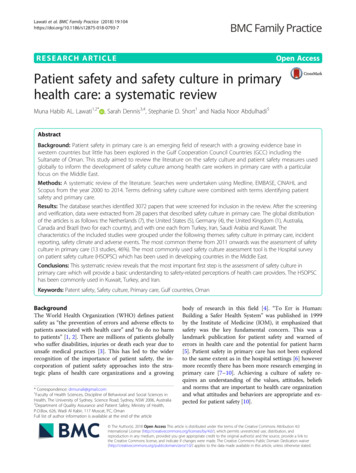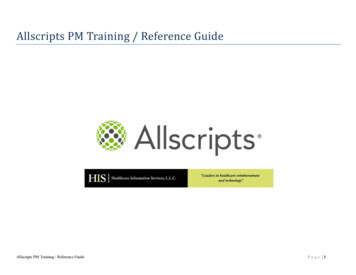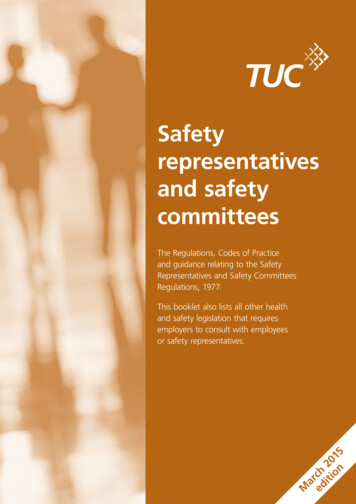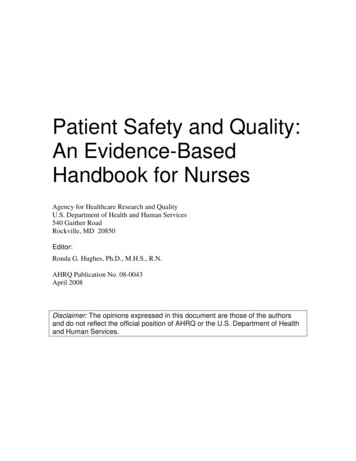
Transcription
Patient Safety and Quality:An Evidence-BasedHandbook for NursesAgency for Healthcare Research and QualityU.S. Department of Health and Human Services540 Gaither RoadRockville, MD 20850Editor:Ronda G. Hughes, Ph.D., M.H.S., R.N.AHRQ Publication No. 08-0043April 2008Disclaimer: The opinions expressed in this document are those of the authorsand do not reflect the official position of AHRQ or the U.S. Department of Healthand Human Services.
This document is in the public domain and may be used and reprinted withoutpermission, except those copyrighted materials noted for which further reproduction isprohibited without specific permission of the copyright holder. Citation of the source isappreciated.Suggested Citation:Hughes RG (ed.). Patient safety and quality: An evidence-based handbook for nurses.(Prepared with support from the Robert Wood Johnson Foundation). AHRQ PublicationNo. 08-0043. Rockville, MD: Agency for Healthcare Research and Quality; March 2008.ii
ForewordThe Agency for Healthcare Research and Quality (AHRQ) and the Robert Wood JohnsonFoundation (RWJF) are pleased to have jointly sponsored the development of this handbook fornurses on patient safety and quality. Patient Safety and Quality: An Evidence-Based Handbookfor Nurses examines the broad range of issues involved in providing high quality and safe careacross health care settings.We know that nurses are at the center of patient care and therefore are essential drivers ofquality improvement. From the Institute of Medicine’s reports, including To Err is Human andKeeping Patient’s Safe: Transforming the Work Environment of Nurses, we know that patientsafety remains one of the most critical issues facing health care today and that nurses are thehealth care professionals most likely to intercept errors and prevent harm to patients. For us, bothat AHRQ and RWJF, improving patient safety and health care quality is embedded in ourmission and at the core of what we do.We strongly believe that the safety and quality of health care in this nation is dependent uponthe availability of the best research possible and on our ability to deliver the results of thatresearch into the hands of providers, policymakers, and consumers so that all can make betterdecisions. We believe the result will be improved health care and safety practices, which will bemanifested in measurably better outcomes for patients.Given the diverse scope of work within the nursing profession in this country, AHRQ and theRWJF expect that the research and concepts presented in the book will be used to improve healthcare quality by nurses in practice, nurse-educators, nurse-researchers, nursing students, andnursing leaders. The 89 contributors to this book represent a broad range of nurse-researchersand senior researchers throughout this nation.The product of this joint effort underscores the commitment of AHRQ and the RWJF toachieving a health care system that delivers higher quality care to everyone. We believe thathigh-quality health care can be achieved through the use of evidence and an enabled andempowered nursing workforce.We welcome written comments on this book. They may be sent to Ronda Hughes, Agencyfor Healthcare Research and Quality, 540 Gaither Road, Rockville, MD 20850.Carolyn M. Clancy, M.D.DirectorAgency for Healthcare Researchand QualityRisa Lavizzo-Mourey, M.D., M.B.A.President and CEORobert Wood Johnson Foundationiii
[This page intentionally left blank.]iv
PrefaceErrors pervade our lives in our homes, on the roads, and in our places of work. Each hour ofeach day, patients and clinicians are affected by near errors and the consequences of adverseevents. The effects of health care errors and poor quality health care have impacted all ourlives—sometimes directly, at other times indirectly. Even during the writing of this book, manyof the authors had firsthand experiences with near errors, adverse events, and a level of poorquality care that should never have been presented to any patient. Given the importance of healthand health care in our lives, the purpose of this book is to bring safety and quality to the forefrontin nursing.Throughout these pages, you will find peer-reviewed discussions and reviews of a wide rangeof issues and literature regarding patient safety and quality health care. Owing to the complexnature of health care, this book provides some insight into the multiple factors that determine thequality and safety of health care as well as patient, nurse, and systems outcomes. Each of these51 chapters and 3 leadership vignettes presents an examination of the state of the science behindquality and safety concepts and challenges the reader to not only use evidence to changepractices but also to actively engage in developing the evidence base to address criticalknowledge gaps. Patient safety and quality care are at the core of health care systems andprocesses and are inherently dependent upon nurses. To achieve goals in patient safety andquality, and thereby improve health care throughout this nation, nurses must assume theleadership role.Despite being a relatively new field of inquiry, particularly in terms of how patient safety andquality are now defined, the need to improve the quality and safety of care is the responsibility ofall clinicians, all health care providers, and all health care leaders and managers. As clinicians,we are obligated to do our best, regardless of whether we are acting as a clinician or a patient.Just as we say there are “good patients” and “bad patients,” clinicians as patients canunfortunately be considered “bad patients” because they may know too much, ask too manyquestions, or are not up-to-date on the research or current practice standards. Yet that is amindset that must end and become a part of history, not to be repeated. Instead, nurses need toensure that they and other team members center health care on patients and their families. Allpatients—whether they include ourselves, our loved ones, or the millions of our neighborsthroughout this country—need to be engaged with clinicians in their care.Each of the chapters in this book is organized with a background section and analysis of theliterature. At the end of each chapter, you will find two critical components. First, there is a“Practice Implications” section that outlines how the evidence can be used to inform practicechanges. Practice leaders and clinicians can use this information, based on the state of thescience, to guide efforts to improve the quality and safety of delivering services to patients.Second, there is a “Research Implications” section that outlines research gaps that can betargeted by researchers and used by clinicians to inform and guide decisions for practice. Facultyand graduate students will find innumerable questions and issues that can be used to developdissertation topics and grant applications to uncover the needed evidence.In all but a few chapters, you will find evidence tables. These tables were developed bycritically assessing the literature, when possible, and present invaluable insight as to the type andquality of research that can inform practice, clarify knowledge gaps, and drive future research.As the reader will observe, the majority of patient safety and quality research presented in theevidence tables represent cross-sectional studies. In fact, 81 percent of the studies exploring thev
various aspects of safety and quality employed cross-sectional study designs, predominatelyrepresenting assessments at single sites of care and using qualitative surveys. This may be thebyproduct of the challenges of the research process (including sources of funding) or thechallenges of engaging in collaborative research. From this review of the literature, we can learnthe importance of the need for longitudinal, multisite analyses to bring us forward into the nextgeneration of evidence-based knowledge.Great is the importance of nurses being involved throughout the research process andcollaborating with interdisciplinary teams throughout care settings. Then, too, it is critical thatnursing leaders and managers, clinical leaders, and nurses across care settings engage in alifelong pursuit of using data and information as well as research evidence to inform practice.Combined with experiential knowledge, analyses, and evidence, nurses will be challenged tocontinuously improve care processes and encourage our peers and interdisciplinary colleagues tomake sure patients receive the best possible care, regardless of where they live, their race orgender, or their socioeconomic circumstances.The chapters in this book are organized into six sections. Each chapter can be readindependently of the others; however, some do make reference to other chapters, and a greaterunderstanding of the breadth and depth of patient safety and quality can be better obtained byreading the book in its entirety. Highlights from the chapters are summarized by section asfollows:In Section I – Patient Safety and Quality, patient safety is discussed as being foundational toquality, where nurses can be invaluable in preventing harm to patients and improving patients’outcomes (chapter 1). Even though the quality and safety of health care is heavily influenced bythe complex nature of health care and multiple other factors, nurses have been held accountablefor harm to patients, even when other clinicians and health care providers and characteristics ofthe care system in which they work often have—almost without exception—greater roles and, insome respects, have ensured that an error would happen (chapters 2 and 3). With the manychallenges facing health care today, the Institute of Medicine’s 11-volume Quality Chasm seriesbrings to light the multitude of issues and factors that individuals and organizations, both withinand outside of nursing and health care, need to understand and to work together to overcome(chapter 4). Moving toward and securing a culture of safety throughout health care will, bydefinition, acknowledge the influence of human factors in all clinicians, the results of humansystem interfaces and system factors, and will institutionalize processes and technology that willmake near errors and errors very rare (chapter 5). This paradigm shift will enable nurses to thinkmore critically and clinically (chapter 6), and to achieve greater insights as to how education,training, and experience are needed and can be leveraged to ultimately achieve high-quality carein every care setting and for all patients.To improve patient safety and quality, one needs to understand the state of the science athand, as well as strategies that can be behind effective utilization of evidence andimplementation of change, as discussed in Section II – Evidence-Based Practice. It is here thatone can learn that implementing evidence into practice can be accomplished though severalapproaches—often more than one simple intervention is possible—and by early on engaging keystakeholders to move toward adoption of change by translating research-based evidence intoeveryday care (chapter 7). Yet in assessing the state of the science, it becomes apparent that themajority of care afforded patients is not evidence based, emphasizing the need for health servicesresearch to examine progress toward safer and higher-quality care and to assess new andinnovative practices (chapter 8). While the future of health care is uncertain, clinicians mustvi
continually assess, understand, and meet the needs of patients and prepare themselves to meetemerging health needs we might not expect (chapter 9).Due to innumerable pressures to improve patient safety and quality, it may be important tofocus on those areas of care delivery, as discussed in Section III – Patient-Centered Care, thatare significantly influenced by nursing care. Providing health care is all about patients and theirneeds and meeting those care needs in settings where the majority of care is provided byclinicians—or, in certain circumstances, where loved ones and family members supplementnursing care or solely provide for the care needs of patients in community settings. Almost allthe adverse events and less-than-optimal care afforded patients can be prevented, beginning byimplementing research in practice. Situations in which failure to use evidence can be detectedcan include when preventable patients falls with injury occur (chapter 10), when illness-relatedcomplications are missed and lead to functional decline in the elderly (chapter 11), and whenpressure ulcers develop in patients of any age (chapter 12). For nurses, ensuring and/or providingevidence-based, safe, and high-quality care become even more challenging when patients needcare in their homes and subsequently rely on care rendered by family members and loved ones—care that can be dependent upon the guidance of nurses (chapter 13). Not only can the resourcesand functionality of the community or home setting pose potential threats to the safety of patientsand may relegate them to care of a lower quality, but those who care for patients may alsosuccumb to the physical and emotional demands of providing informal care; amelioration canrequire broadening nursing care to caregivers (chapter 14).Nursing can also have a significant effect on the outcomes of specific groups of patients,particularly in preventing not only adverse events but the lasting effects of comorbidities andsymptoms. The reason behind focusing on these specific populations is that their unique needsmust not be considered less important than those of the majority. In the case of children, who aresome of the most vulnerable patients due to developmental and dependency factors, it is difficultto provide safe, high-quality care that meets their unique needs. Instead, nurses need to usecurrent best practices (chapter 15) to avert potentially lifelong comorbidities and addresssymptoms—and develop new practices when the evidence is not available. It is also important tofocus on simple strategies to prevent morbidity—not just preventing adverse events—and ensurethat patients receive preventive care services whenever possible, especially when the use of theseservices is supported by evidence (chapter 16). Especially for patients with moderate to severepain, it is also important to prevent the adverse effects of their diseases and conditions byworking with patients to manage their pain, promoting healing and improving function (chapter17). And finally, in the case of potential adverse effects of polypharmacy in the elderly, nursescan also focus on simple strategies to improve adherence to intended therapies and detectunnecessary side effects, thereby improving medication safety (chapter 18).Beyond the influence of evidence on quality processes and outcomes, there are health caresystem and organization factors and characteristics to consider. As discussed in Section IV –Working Conditions and the Work Environment for Nurses, evidence concerning the impact ofhealth care system factors illustrates that working conditions and the work environment, whichare heavily influenced by leaders, can have a greater impact on the safety and quality of healthcare than what an individual clinician can do. Instead of aggregating the various aspects ofworking conditions, the chapters in this section define and focus on specific aspects of keyfactors associated with patient and systems outcomes, centering on the importance of leadership.The leadership and management of health care organizations and health systems are pivotalto safer and higher quality of care because they direct and influence: which model of care is usedvii
to organize inpatient care services for patients (chapter 19); whether or not the organizationembraces and is committed to fostering and sustaining a climate of safety and high-quality care(chapter 21); the impact of external factors, and the functionality and organization ofmicrosystems within the context of the organization and relationships with others (chapter 22);how the specific care needs of patients are met with sufficient numbers of the right types ofnurses (chapter 23 and chapter 25); how resource allocations and cost-saving strategies thatinvolve restructuring, mergers, and organizational turbulence impact care delivery and patientoutcomes (chapter 24 and chapter 29); the type of work environment that influences work stressand patient outcomes (chapter 26 and chapter 27); and how the actual physical environment andcare processes influence the workload and workflow of nursing care (chapter 28, chapter 30,chapter 31).Taken together, leadership throughout organizations, led by nurse executives and influencedby physicians, is critical in determining whether or not safety and high-quality care can beachieved through daily teamwork, collaboration, and communication (chapter 20). It is becauseof the importance of senior nursing leadership that emphasis is put on the moral imperative thatsenior nursing leadership has to lead health care in the quest for safer and higher-quality care(vignette a), to demonstrate the right type of leadership (vignette b), and to excel in the rightcompetencies (e.g., business skills and principles, communication and relationship management,and professionalism) (vignette c).Nursing leaders must actively work with and enable staff to transform the current workclimate and care delivery. Section V – Critical Opportunities for Patient Safety and QualityImprovement puts forth several critical opportunities that leaders and staff can work together toachieve success. In almost every care setting and situation, effective communication is essential.Not only do clinicians need to constantly communicate in a professional and technical way(chapter 32) and with team members in a way that is respectful and attuned to individualdifferences (chapter 33), clinicians must also ensure that the right information is communicatedto next caregiver or health care provider so that the safety and quality of care is not compromised(chapter 34).Other opportunities for improvement center on the necessity to continually assess near errorsand errors, not only those events that harm patients, and put in place strategies to avert therecurrence of both the near error and errors. Assessing and evaluating near errors and errors—and the ability to avert the recurrence of errors—is dependent upon having information that isreported by clinicians (chapter 35), so that some errors (e.g., wrong-site surgery) never happen(chapter 36). Many initiatives to improve patient safety and health care quality have focused onmedication safety. While many medication errors are prevented from harming patients because anurse detected the error, monitoring and evaluating both near misses and adverse drug events canlead to the adoption of strategies to decrease the opportunities for errors, including unit dosing,using health information technology (chapter 37), and reconciling a patient’s medications(chapter 38).The nature of the work and the stress of caregiving can place nurses and patients at risk forharm. Moving patients, being in close proximity to therapeutic interventions, the implications ofshift work and long work hours (chapter 39 and chapter 40), and ignoring the potential risk ofinjury and the impact of fatigue can increase the risk of occupational injury. It follows then that,because of the nature of the work, the proximity of nurses to patients, and the chronic and acuteneeds of patients, particular attention must be given to preventing health care–associatedinfections through known effective strategies, such as environmental cleanliness, hand hygiene,viii
protective barriers (chapter 41), and strategies to address ventilator-acquired pneumonia (chapter42).The influence of nurse practitioners and of the new generation of doctorate-level nurseclinicians has the potential of enabling significant improvements in critical opportunities forpatient safety and quality improvement (chapter 43). The opportunities to demonstrate theinfluence of these clinical leaders is endless. The last section of this book, Section VI – Tools forQuality Improvement and Patient Safety, focuses on the strategies and technologies that can beused to push health care to the next level of quality. One of the tools that can be used is qualitymethods, including continuous quality improvement, root cause analysis, and plan-do-study-act(chapter 44). Quality and patient safety indicators can also be used to assess performance andmonitor improvement (chapter 45). These, as well as other tools, are integral in efforts to developand demonstrate nursing excellence (chapter 46). With recent developments in informationtechnologies, there are many potential benefits that can be afforded by these technologies thatcan facilitate decisionmaking, communication of patient information (chapter 47, chapter 48,chapter 49), therapeutic interventions (so long as the information technologies are used andfunction properly) (chapter 49), and education and training (chapter 51).All of these various issues and factors come together to define the complexity and scope ofpatient safety and quality care but also the necessity for multifaceted strategies to create changewithin health care systems and processes of care. In using evidence in practice, engaging ininitiatives to continually improve quality, and striving for excellence, nurses can capitalize on theinformation from this book and lead health care in the direction that it should and needs to beheading to better care for the needs of patients. What it all comes down to is for us, as nurses, todecide what kind of care we would want as patients then to do all that is possible to make thathappen. Today we may be doing what we can, but tomorrow we can improve. With this evidenceand the call to action to nurses, in 5 years from now, headlines and research findings shouldcarry forth the message that there are significant improvements in the quality and safety of healthcare throughout this nation, and it was because nurses led the way.Ronda G. HughesEditorix
[This page intentionally left blank.]x
Peer ReviewersElaine Larson—Columbia University, NYKathy Lee—University of California at SanFrancisco, CAMichael Leonard—Kaiser Permante, CASally Lusk—University of Michigan, MIDavid Meyers—AHRQ, MDJack Needleman—University of Californiaat Los Angeles, CAD.E.B. Potter—AHRQ, MDPeter Pronovost—Johns Hopkins University,MDAmanda Rischbieth—AustraliaCarol Romano—DHHS/USPHS, MDJudy Sangel - AHRQ, MDCynthia Scalzi—University of Pennsylvania,PACarol Scholle—University of PittsburghMedical Center Presbyterian Hospital, PAJean Ann Seago—University of Californiaat San Francisco, CAJoan Shaver—University of Illinois atChicago, ILMaria Shirey—Shirey & Associates, INJean Slutsky—AHRQ, MDKaye Spence—Children’s Hospital atWestmead, Sydney, AustraliaJanet Tucker—University of Aberdeen,United KingdomTasnim Vira—University of Toronto,OntarioJudith Warren—University of Kansas, KSJon White—AHRQ, MDZane Robinson Wolf—La Salle University,PALaura Zitella—Stanford University CancerCenter, CADaleen Aragon—Orlando RegionalHealthcare, FLWilliam Baine—AHRQ, MDMary Barton—AHRQ, MDMary Blegen—University of California atSan Francisco, CABarbara Braden—Creighton University, NENancy Bergstrom—University of Texas,Houston, TXPeter Bruehaus—Vanderbilt University, TNHelen Burstin—National Quality Forum,DCCarol Cain—Kaiser Permante, CACarolyn Clancy—AHRQ, MDSean Clarke—University of Pennsylvania,PAMarilyn Chow—Kaiser Permante, CABeth Collins-Sharp—AHRQ, MDKathy Crosson—AHRQ, MDLinda Lindsey Davis—Duke University, NCEllen Mockus D’Errico—Loma LindaUniversity, CAJoanne Disch—University of Minnesota,MNAnita Hanrahan—Capital Health,Edmonton, AlbertaAparana Higgins—Booz Allen Hamilton,NYKerm Henrickson—AHRQ, MDJudith Hertz—Northern Illinois University,ILRonda Hughes—AHRQ, MDRainu Kaushal—Harvard-Partners, MARon Kaye—FDA, MDMarge Keyes—AHRQ, MDChristine Kovner—New York University,NYJeanette Lancaster—University of Virginia,VADavid Lanier—AHRQ, MDxi
Contributing AuthorsAmy S. Collins, B.S., B.S.N., M.P.H.Centers for Disease Control andPreventionKaren Cox, R.N., Ph.D., C.N.A.A.,F.A.A.N.Children’s Mercy Hospitals and Clinics,Kansas City, MOLeanne Currie, D.N.Sc., M.S.N., R.N.Columbia University School of NursingMargaret J. Cushman, Ph.D.(c), R.N.,F.H.H.C., F.A.A.N.University of Massachusetts at BostonMaureen Ann Dailey, R.N., M.S.Columbia University School of NursingElizabeth Dayton, M.A.Johns Hopkins UniversityAndrea Deickman, M.S.N., R.N.iTelehealth Inc.Joanne Disch, Ph.D., R.N., F.A.A.N.University of Minnesota School ofNursingMolla Sloane Donaldson, Dr.P.H., M.S.M.S.D. HealthcareNancy E. Donaldson, R.N., D.N.Sc.,F.A.A.N.University of California, San Francisco,School of NursingCarol Fowler Durham, M.S.N., R.N.,University of North Carolina at ChapelHillVictoria Elfrink, Ph.D., R.N.B.C.College of Nursing of Ohio StateUniversity and iTelehealth Inc.Carol Hall Ellenbecker, Ph.D., R.N.University of Massachusetts at BostonMarybeth Farquhar, R.N., M.S.N., C.A.G.S.Agency for Healthcare Research andQualityKathy Fletcher, R.N., G.N.P., A.P.R.N.B.C., F.A.A.N.University of Virginia Health SystemKathryn Rhodes Alden, M.S.N., R.N.,I.B.C.L.C.University of North Carolina at ChapelHillKristine Alster, Ed.D., R.N.University of Massachusetts at BostonLisa Antle, A.P.R.N., B.C., A.P.N.PUniversity of Wisconsin MilwaukeeCollege of NursingElizabeth A. Ayello, Ph.D., R.N., A.P.R.N.,B.C., C.W.O.C.N., F.A.P.W.C.A.,F.A.A.N.Advances in Skin and Wound CareJane H. Barnsteiner, Ph.D., R.N., F.A.A.N.University of Pennsylvania School ofNursing and Hospital of the University ofPennsylvaniaAnn Bemis, M.L.S.Rutgers, The State University of NewJerseyPatricia Benner, R.N., Ph.D., F.A.A.N.Carnegie Foundation for the Advancementof TeachingMary A. Blegen, Ph.D., R.N., F.A.A.N.School of Nursing, University ofCalifornia, San FranciscoJacqueline F. Byers, Ph.D., R.N., C.N.A.A.,C.P.H.Q.College of Nursing, University of CentralFlorida, OrlandoCarol H. Cain, Ph.D.Care Management Institute, KaiserPermanentePascale Carayon, Ph.D.University of Wisconsin-MadisonClaire C. Caruso, Ph.D., R.N.National Institute for Occupational Safetyand HealthSean P. Clarke, R.N., Ph.D., C.R.N.P.,F.A.A.N.University of Pennsylvania School ofNursingxii
Patient Safety and Quality: An Evidence-Based Handbook for NursesCourtney H. Lyder, N.D., G.N.P., F.A.A.N.University of VirginiaMary Mandeville, M.B.A.University of Illinois, ChicagoKaren Dorman Marek, Ph.D., M.B.A., R.N.,F.A.A.N.University of Wisconsin MilwaukeeCollege of NursingDiana J. Mason, R.N., Ph.D., F.A.A.N.American Journal of NursingMargo McCaffery, R.N., F.A.A.N.Pain management consultantPamela H. Mitchell, Ph.D., R.N., C.N.R.N.,F.A.A.N., F.A.H.A.University of Washington School ofNursingDeborah F. Mulloy, M.S.N., C.N.O.R.,Doctoral studentUniversity of Massachusetts at BostonSchool of NursingCindy L. Munro, R.N., A.N.P., Ph.D.,F.A.A.N.Virginia Commonwealth UniversitySchool of NursingMike R. Murphy, R.N., B.S.N., M.B.A.Synergy Health/St. Joseph’s HospitalAudrey L. Nelson, Ph.D., R.N., F.A.A.N.James A. Haley Veterans’ Hospital,Tampa, FLMichelle O’Daniel, M.H.A., M.S.G.,VHA West CoastEileen T. O’Grady, Ph.D., R.N., N.P.Nurse Practitioner World News and TheAmerican Journal for Nurse PractitionersAnn E. K. Page, R.N., M.P.H.Institute of MedicineChris Pasero, R.N.Pain management consultantEmily S. Patterson, Ph.D.Cincinnati VA Medical Center and OhioState UniversityNirvana Huhtala PetlickRutgers, The State University of NewJerseyShobha Phansalkar, R.Ph., Ph.D.Harvard Medical SchoolMary Ann Friesen, M.S.N., R.N., C.P.H.Q.Center for American Nurses, SilverSpring, MDJeanne M. Geiger-Brown, Ph.D., R.N.University of Maryland School of NursingKaren K. Giuliano, R.N., Ph.D., F.A.A.N.Philips Medical SystemsBarbara Given, Ph.D., R.N., F.A.A.N.Michigan State University College ofNursingAyse P. GursesUniversity of Minnesota-Twin CitiesSaira Haque, M.H.S.A., Doctoral candidateSyracuse UniversityKerm Henriksen, Ph.D.Agency for Healthcare Research andQualityRonda G. Hughes, Ph.D., M.H.S., R.N.Agency for Healthcare Research andQualityBonnie M. Jennings, D.N.Sc., R.N.,F.A.A.N.Colonel, U.S. Army (Retired) and healthcare consultantMeg Johantgen, Ph.D., R.N.University of Maryland School of NursingGail M. Keenan, Ph.D., R.N.University of Illinois, ChicagoMargaret A. Keyes, M.A.Agency for Healthcare Research andQualityRuth M. Kleinpell, Ph.D., R.N., F.A.A.N.Rush University College of Nursing,Chicago, ILSusan R. Lacey, R.N., Ph.D.Nursing Workforce and Systems Analysis,Children’s Mercy Hospitals and Clinics,Kansas City, MOJane A. Lipscomb, Ph.D., R.N., F.A.A.N.University of Maryland School of NursingCarol J. Loveland-Cherry, Ph.D., R.N.,F.A.A.N.University of Michigan School of NursingVicki A. Lundmark, Ph.D.American Nurses Credentialing Centerxiii
Contributing AuthorsJanis B. Smith, R.N., M.S.N.Children’s Mercy Hospitals and Clinics,Kansas City, MOElizabeth S. SouleUniversity of Washington School ofNursingNancy Staggers, Ph.D., R.N., F.A.A.N.University of Utah College of Nursing andSchool of MedicineDonald Steinwachs, Ph.D.Johns Hopkins UniversityPatricia W. Stone, Ph.D., M.P.H., R.N.Columbia University School of NursingMolly Sutphen, Ph.D.Carnegie Foundation for the Advancementof TeachingMarita G. Titler, Ph.D., R.N., F.A.A.N.University of Iowa Hospitals and ClinicsAlison M. Trinkoff, Sc.D., R.N., F.A.A.N.University of Maryland School of NursingDana Tschannen, Ph.D., R.N.University of Michigan.Mary Wakefield, Ph.D., R.N., F.A.A.N.University of North Dakota, Grand ForksCharlene Weir, Ph.D., R.N.VA Geriatric Research Education andClinical Centers, Salt Lake City, UTNancy Wells, D.N.Sc., R.N., F.A.A.N.Vanderbilt Medical Center and VanderbiltUniversity School of NursingSusan V. White, Ph.D., R.N., C.P.H.Q.,F.N.A.H.Q.James A.
From the Institute of Medicine's reports, including To Err is Human and Keeping Patient's Safe: Transforming the Work Environment of Nurses, we know that patient safety remains one of the most critical issues facing health care today and that nurses are the health care professionals most likely to intercept errors and prevent harm to patients.
